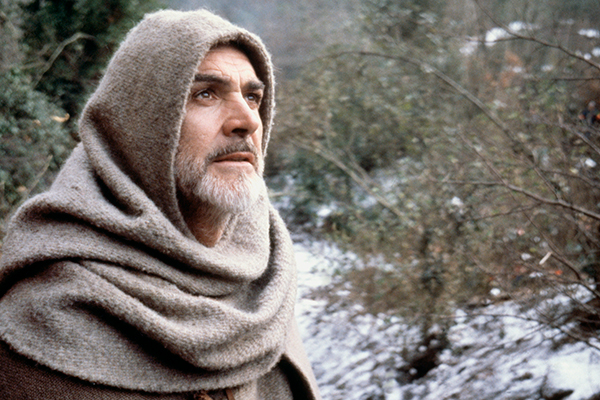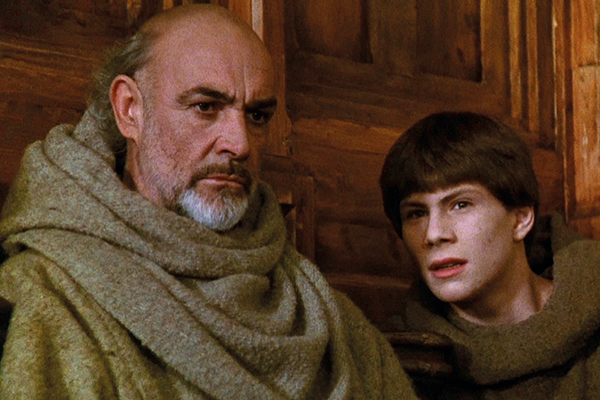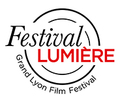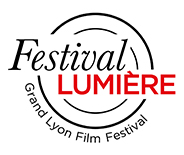Jean-Jacques Annaud’s
exaltation of Umberto Eco
Posted on 22.10.2023
Since its release in 1986, Jean-Jacques Annaud's The Name of the Rose has reached the status of a cult film. (Re)discovering it on the big screen at the Lumière film festival gives us an opportunity to look back at the history of this huge international success.

Le Nom de la rose, 1986 © Neue Constantin / DR
In 1980, Italian writer and great scholar Umberto Eco (1932-2016) published a medieval crime thriller, written as a kind of parody, he claimed, for his students’ amusement. To his great surprise, the book immediately became a bestseller, the most widely read Italian work in the world. But what was it about? In 1327, Benedictine monks were murdered in an abbey that housed a library, the only one of its kind on earth. Guillaume de Baskerville (William of Baskerville in the anglophone version), a Franciscan monk, flanked by a young novice, Adso, conducted the investigation.
"It was the kind of film [a thriller] that was missing from my repertoire", explains Jean-Jacques Annaud about Eco’s work that he had decided to adapt. Annaud, a young star filmmaker, was on the heels of three daringly successful films: Quest for Fire (La Guerre du feu, 1981) a prehistoric love story, and two biting comedies, Black and White in Color (La Victoire en chantant, 1976), which garnered the Oscar for Best Foreign Film, and Hothead (Coup de tête, 1979). The writer-philosopher and Annaud became friends at first sight. At the time of Umberto Eco’s death, the director would remember him as an eminent scholar and a true bon vivant.
For the adaptation, which Annaud described as a palimpsest of the book, in reference to the multi-layered, medieval manuscripts that were at the heart of the intrigue, his screenwriters Gérard Brach, Alain Godard, Andrew Birkin and Howard Franklin ended up producing fifteen versions.
The abbey, a crucial character of the story, also had to be found. After visiting some 300 sites, the choice fell on a 12th-century monument, later fitted out by the legendary artistic director Dante Ferretti. The set was once described as the largest outdoor installation in Europe since Cleopatra (1963). Other parts of the set were recreated at Cinecittà in Rome, including a library with extraordinary staircases, the ideal spot for acrobatic action scenes. All that remained was to invent a powerful visual universe for this hybrid story, both a literary tale and a horrific fantasy. In 1986, the film's cinematographer Tonino Delli Colli gave a detailed account of his work to American Cinematographer. Annaud was looking for a visually aesthetic approach to a romantic Middle Ages worthy of Victor Hugo, influenced by Gustave Doré's fairy-tale wood-engraved illustrations. For the interior lighting, the filmmaker wanted chiaroscuro reminiscent of Rembrandt, Jan Steen and Jean Latour, while the collective madness of the exterior was to be inspired by Brueghel and Jérôme Bosch. Some 3,000 drawings by Feretti were produced, notably for the furniture, which was entirely hand-built in Italy. Every detail was recreated, from the costumes to the special lighting of a manuscript that cost a fortune; the medieval document was entirely rewritten by hand and gilded in fine gold.

Le Nom de la rose, 1986 © Neue Constantin / DR
To illuminate all this, at a meeting at Cinecittà, in Feretti's offices, Annaud explained to Delli Colli that he was going to have to invent a way to produce light in dark rooms, complicated by the fact that, at the time, windows were minuscule to protect against the cold of winter. Lanterns were devised that were very heavy for the actors to carry, and whose glow, for complete plausibility, had to be approved by a French historian in Paris. The other major challenge was casting. For Guillaume de Baskerville, Annaud wanted to bring on an unknown, but it was a superstar who hounded him for the role. On the France Inter radio programme La Bande originale, the filmmaker recalled how Sean Connery called him every fortnight to persuade Annaud to hire him. The filmmaker refused several times, until one day his producer said, "I have a surprise for you. Sean Connery is coming to see you.” The Scottish actor arrived in the director's office and Annaud remembers: "I was flabbergasted. I didn't think he could be so handsome in real life. I have to say that I was overwhelmed by his charisma. He had the script tucked under his arm. He sat down in front of me and said ‘Listen, boy’, in his beautiful deep voice... He opened the script and played the part for me. I swear I got goose bumps. After two pages, I stopped him, saying, 'It's marvellous, it's wonderful.’”
Winner of the César Award for Best Foreign Film in 1987, the film went on to earn more than $77 million worldwide. To see it again today, apart from noting that Connery invented the first intellectual blockbuster “superhero”, is to realise what a visionary writer Umberto Eco was, in his way of denouncing superstition, always idiotic, while understanding the vital value of laughter and humour, so feared by zealots.
Virginie Apiou
CLOSING SCREENING
The Name of the Rose by Jean-Jacques Annaud (Le Nom de la rose, 1986, 2h12)
Halle Tony Garnier – Sunday, 22 October at 2.45pm
MASTER CLASS
Meet Jean-Jacques Annaud
Pathé Bellecour - Sunday, 22 October at 10.30am

